World of Math: Examining Numeracy and Mathematics Concepts
VerifiedAdded on 2019/10/30
|17
|4407
|169
Report
AI Summary
This report provides an overview of the concepts of mathematics and numeracy, highlighting their similarities and differences. It emphasizes the importance of mathematics as a foundational subject and numeracy as a crucial skill developed through mathematical understanding. The report explores early numeracy learning in preschool, discussing factors influencing development and effective teaching strategies such as using games and real-world examples. It examines the role of planned and incidental play experiences in fostering numeracy skills, the influence of the learning environment, and the importance of creating conducive learning environments. Additionally, the report analyzes mathematics in primary school, its relationship to potential career paths, and the need for a comprehensive learning approach. Finally, the report discusses the impact of the learning environment on math and science subjects and the importance of a mixed learning environment for optimal student development. The report draws on various resources and research to support its findings, offering insights into effective teaching methods and the importance of a well-rounded approach to mathematics education.
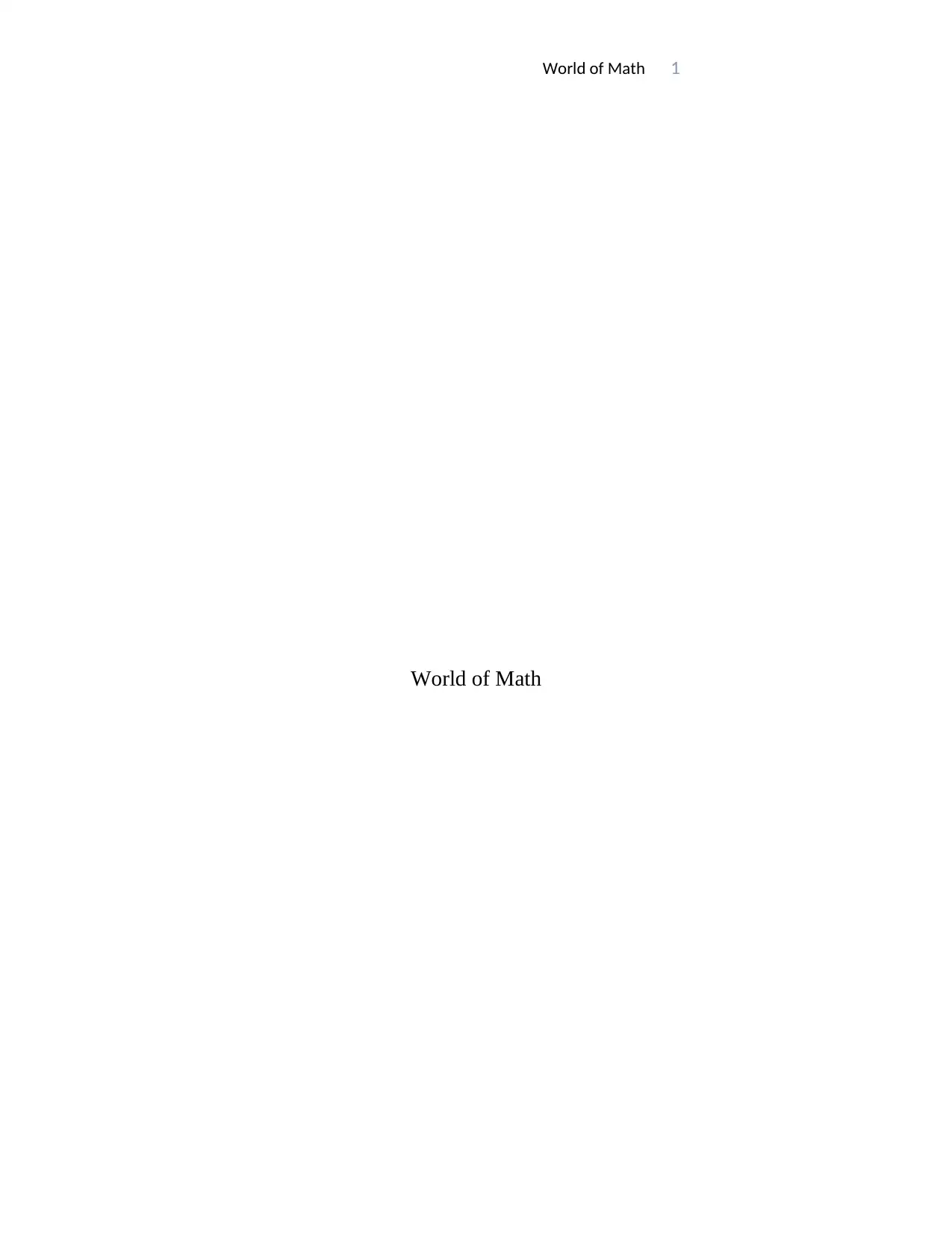
World of Math 1
World of Math
World of Math
Paraphrase This Document
Need a fresh take? Get an instant paraphrase of this document with our AI Paraphraser
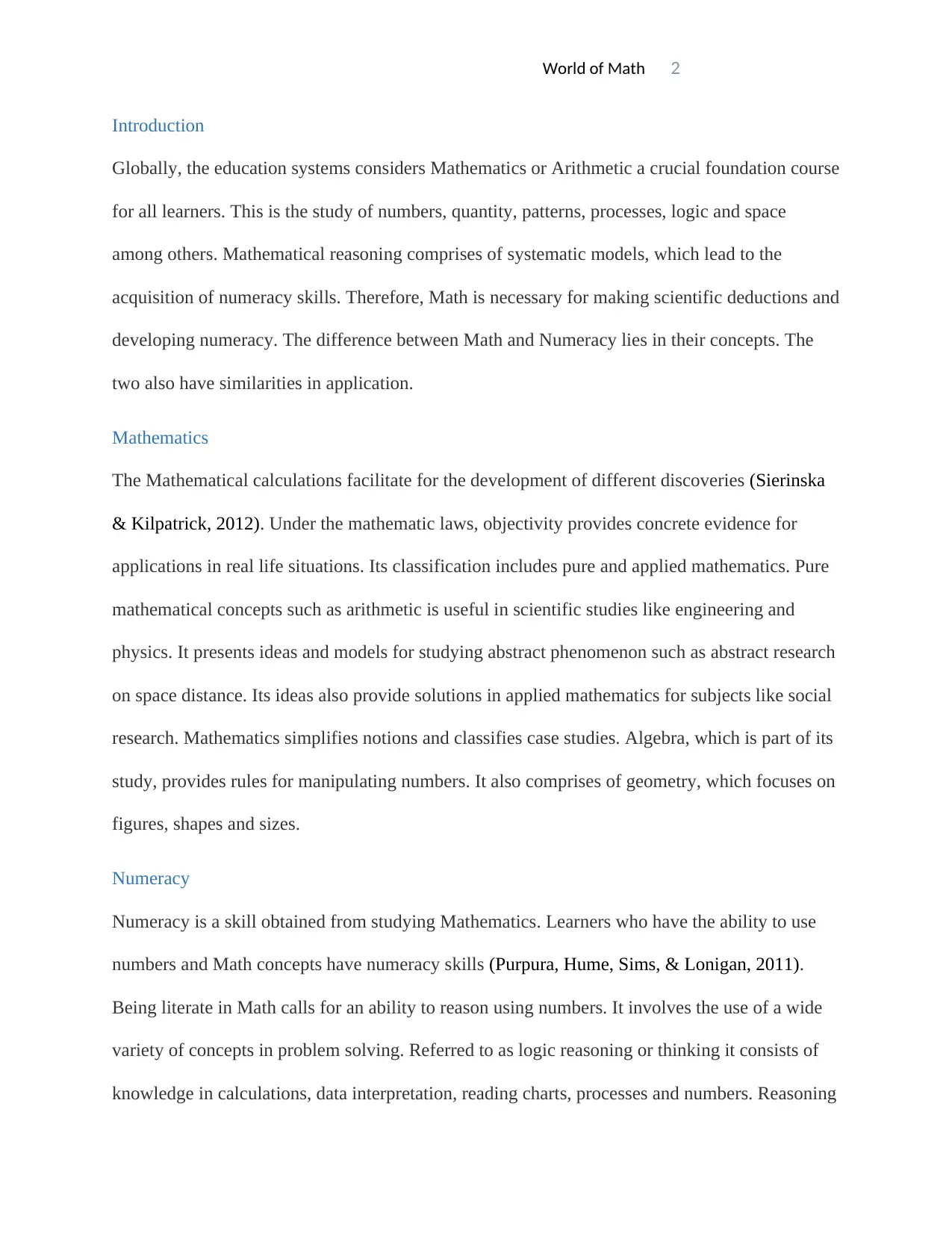
World of Math 2
Introduction
Globally, the education systems considers Mathematics or Arithmetic a crucial foundation course
for all learners. This is the study of numbers, quantity, patterns, processes, logic and space
among others. Mathematical reasoning comprises of systematic models, which lead to the
acquisition of numeracy skills. Therefore, Math is necessary for making scientific deductions and
developing numeracy. The difference between Math and Numeracy lies in their concepts. The
two also have similarities in application.
Mathematics
The Mathematical calculations facilitate for the development of different discoveries (Sierinska
& Kilpatrick, 2012). Under the mathematic laws, objectivity provides concrete evidence for
applications in real life situations. Its classification includes pure and applied mathematics. Pure
mathematical concepts such as arithmetic is useful in scientific studies like engineering and
physics. It presents ideas and models for studying abstract phenomenon such as abstract research
on space distance. Its ideas also provide solutions in applied mathematics for subjects like social
research. Mathematics simplifies notions and classifies case studies. Algebra, which is part of its
study, provides rules for manipulating numbers. It also comprises of geometry, which focuses on
figures, shapes and sizes.
Numeracy
Numeracy is a skill obtained from studying Mathematics. Learners who have the ability to use
numbers and Math concepts have numeracy skills (Purpura, Hume, Sims, & Lonigan, 2011).
Being literate in Math calls for an ability to reason using numbers. It involves the use of a wide
variety of concepts in problem solving. Referred to as logic reasoning or thinking it consists of
knowledge in calculations, data interpretation, reading charts, processes and numbers. Reasoning
Introduction
Globally, the education systems considers Mathematics or Arithmetic a crucial foundation course
for all learners. This is the study of numbers, quantity, patterns, processes, logic and space
among others. Mathematical reasoning comprises of systematic models, which lead to the
acquisition of numeracy skills. Therefore, Math is necessary for making scientific deductions and
developing numeracy. The difference between Math and Numeracy lies in their concepts. The
two also have similarities in application.
Mathematics
The Mathematical calculations facilitate for the development of different discoveries (Sierinska
& Kilpatrick, 2012). Under the mathematic laws, objectivity provides concrete evidence for
applications in real life situations. Its classification includes pure and applied mathematics. Pure
mathematical concepts such as arithmetic is useful in scientific studies like engineering and
physics. It presents ideas and models for studying abstract phenomenon such as abstract research
on space distance. Its ideas also provide solutions in applied mathematics for subjects like social
research. Mathematics simplifies notions and classifies case studies. Algebra, which is part of its
study, provides rules for manipulating numbers. It also comprises of geometry, which focuses on
figures, shapes and sizes.
Numeracy
Numeracy is a skill obtained from studying Mathematics. Learners who have the ability to use
numbers and Math concepts have numeracy skills (Purpura, Hume, Sims, & Lonigan, 2011).
Being literate in Math calls for an ability to reason using numbers. It involves the use of a wide
variety of concepts in problem solving. Referred to as logic reasoning or thinking it consists of
knowledge in calculations, data interpretation, reading charts, processes and numbers. Reasoning
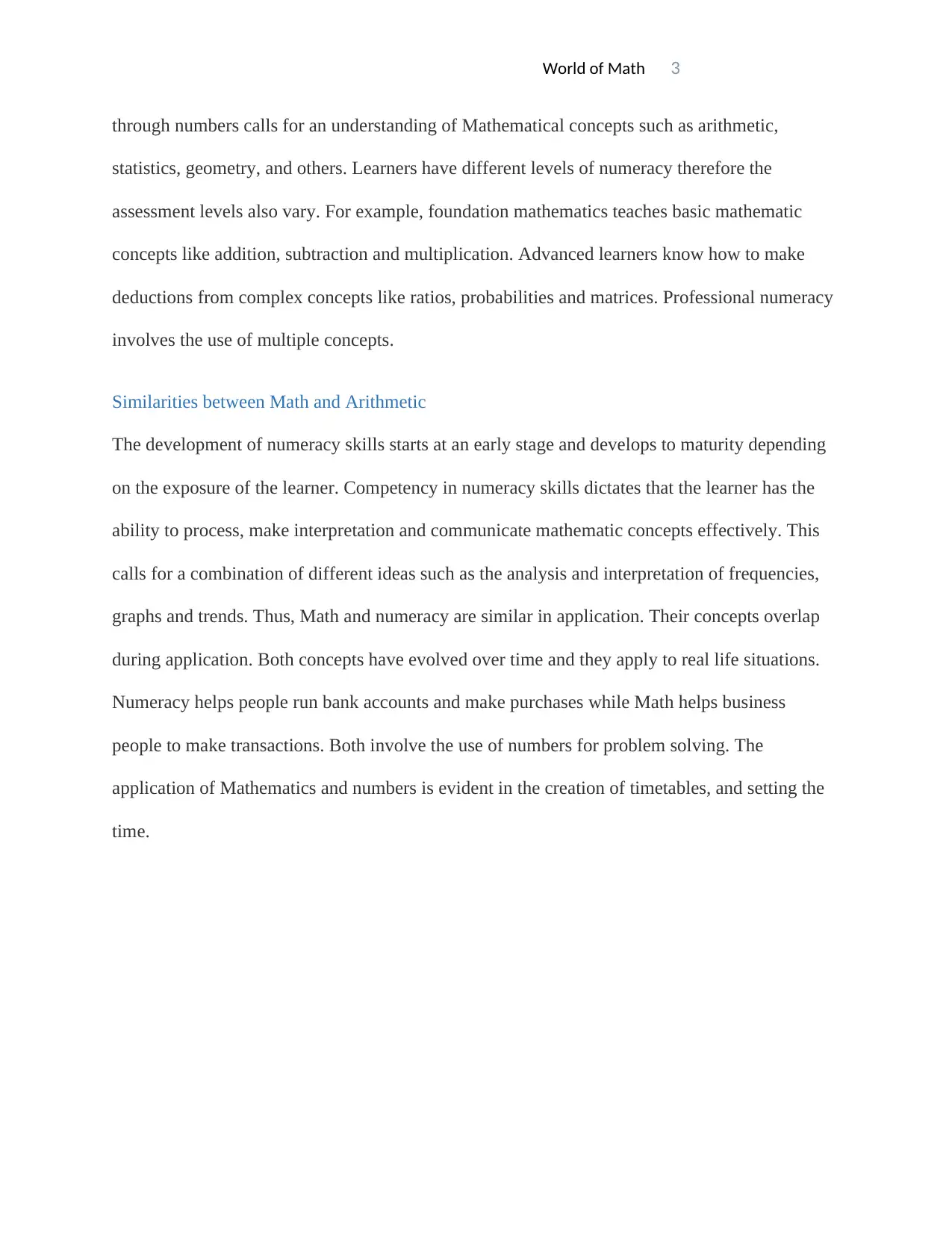
World of Math 3
through numbers calls for an understanding of Mathematical concepts such as arithmetic,
statistics, geometry, and others. Learners have different levels of numeracy therefore the
assessment levels also vary. For example, foundation mathematics teaches basic mathematic
concepts like addition, subtraction and multiplication. Advanced learners know how to make
deductions from complex concepts like ratios, probabilities and matrices. Professional numeracy
involves the use of multiple concepts.
Similarities between Math and Arithmetic
The development of numeracy skills starts at an early stage and develops to maturity depending
on the exposure of the learner. Competency in numeracy skills dictates that the learner has the
ability to process, make interpretation and communicate mathematic concepts effectively. This
calls for a combination of different ideas such as the analysis and interpretation of frequencies,
graphs and trends. Thus, Math and numeracy are similar in application. Their concepts overlap
during application. Both concepts have evolved over time and they apply to real life situations.
Numeracy helps people run bank accounts and make purchases while Math helps business
people to make transactions. Both involve the use of numbers for problem solving. The
application of Mathematics and numbers is evident in the creation of timetables, and setting the
time.
through numbers calls for an understanding of Mathematical concepts such as arithmetic,
statistics, geometry, and others. Learners have different levels of numeracy therefore the
assessment levels also vary. For example, foundation mathematics teaches basic mathematic
concepts like addition, subtraction and multiplication. Advanced learners know how to make
deductions from complex concepts like ratios, probabilities and matrices. Professional numeracy
involves the use of multiple concepts.
Similarities between Math and Arithmetic
The development of numeracy skills starts at an early stage and develops to maturity depending
on the exposure of the learner. Competency in numeracy skills dictates that the learner has the
ability to process, make interpretation and communicate mathematic concepts effectively. This
calls for a combination of different ideas such as the analysis and interpretation of frequencies,
graphs and trends. Thus, Math and numeracy are similar in application. Their concepts overlap
during application. Both concepts have evolved over time and they apply to real life situations.
Numeracy helps people run bank accounts and make purchases while Math helps business
people to make transactions. Both involve the use of numbers for problem solving. The
application of Mathematics and numbers is evident in the creation of timetables, and setting the
time.
⊘ This is a preview!⊘
Do you want full access?
Subscribe today to unlock all pages.

Trusted by 1+ million students worldwide
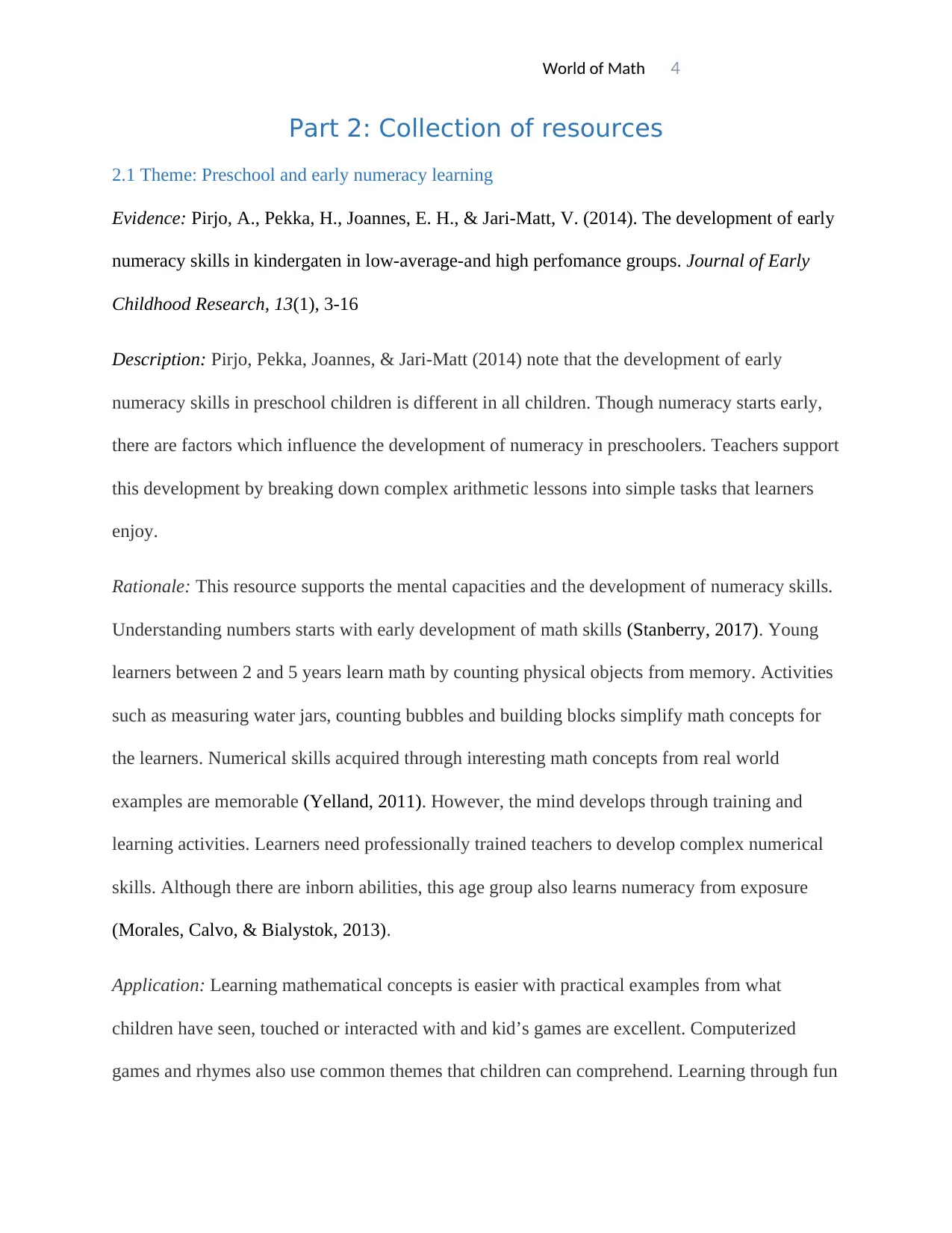
World of Math 4
Part 2: Collection of resources
2.1 Theme: Preschool and early numeracy learning
Evidence: Pirjo, A., Pekka, H., Joannes, E. H., & Jari-Matt, V. (2014). The development of early
numeracy skills in kindergaten in low-average-and high perfomance groups. Journal of Early
Childhood Research, 13(1), 3-16
Description: Pirjo, Pekka, Joannes, & Jari-Matt (2014) note that the development of early
numeracy skills in preschool children is different in all children. Though numeracy starts early,
there are factors which influence the development of numeracy in preschoolers. Teachers support
this development by breaking down complex arithmetic lessons into simple tasks that learners
enjoy.
Rationale: This resource supports the mental capacities and the development of numeracy skills.
Understanding numbers starts with early development of math skills (Stanberry, 2017). Young
learners between 2 and 5 years learn math by counting physical objects from memory. Activities
such as measuring water jars, counting bubbles and building blocks simplify math concepts for
the learners. Numerical skills acquired through interesting math concepts from real world
examples are memorable (Yelland, 2011). However, the mind develops through training and
learning activities. Learners need professionally trained teachers to develop complex numerical
skills. Although there are inborn abilities, this age group also learns numeracy from exposure
(Morales, Calvo, & Bialystok, 2013).
Application: Learning mathematical concepts is easier with practical examples from what
children have seen, touched or interacted with and kid’s games are excellent. Computerized
games and rhymes also use common themes that children can comprehend. Learning through fun
Part 2: Collection of resources
2.1 Theme: Preschool and early numeracy learning
Evidence: Pirjo, A., Pekka, H., Joannes, E. H., & Jari-Matt, V. (2014). The development of early
numeracy skills in kindergaten in low-average-and high perfomance groups. Journal of Early
Childhood Research, 13(1), 3-16
Description: Pirjo, Pekka, Joannes, & Jari-Matt (2014) note that the development of early
numeracy skills in preschool children is different in all children. Though numeracy starts early,
there are factors which influence the development of numeracy in preschoolers. Teachers support
this development by breaking down complex arithmetic lessons into simple tasks that learners
enjoy.
Rationale: This resource supports the mental capacities and the development of numeracy skills.
Understanding numbers starts with early development of math skills (Stanberry, 2017). Young
learners between 2 and 5 years learn math by counting physical objects from memory. Activities
such as measuring water jars, counting bubbles and building blocks simplify math concepts for
the learners. Numerical skills acquired through interesting math concepts from real world
examples are memorable (Yelland, 2011). However, the mind develops through training and
learning activities. Learners need professionally trained teachers to develop complex numerical
skills. Although there are inborn abilities, this age group also learns numeracy from exposure
(Morales, Calvo, & Bialystok, 2013).
Application: Learning mathematical concepts is easier with practical examples from what
children have seen, touched or interacted with and kid’s games are excellent. Computerized
games and rhymes also use common themes that children can comprehend. Learning through fun
Paraphrase This Document
Need a fresh take? Get an instant paraphrase of this document with our AI Paraphraser
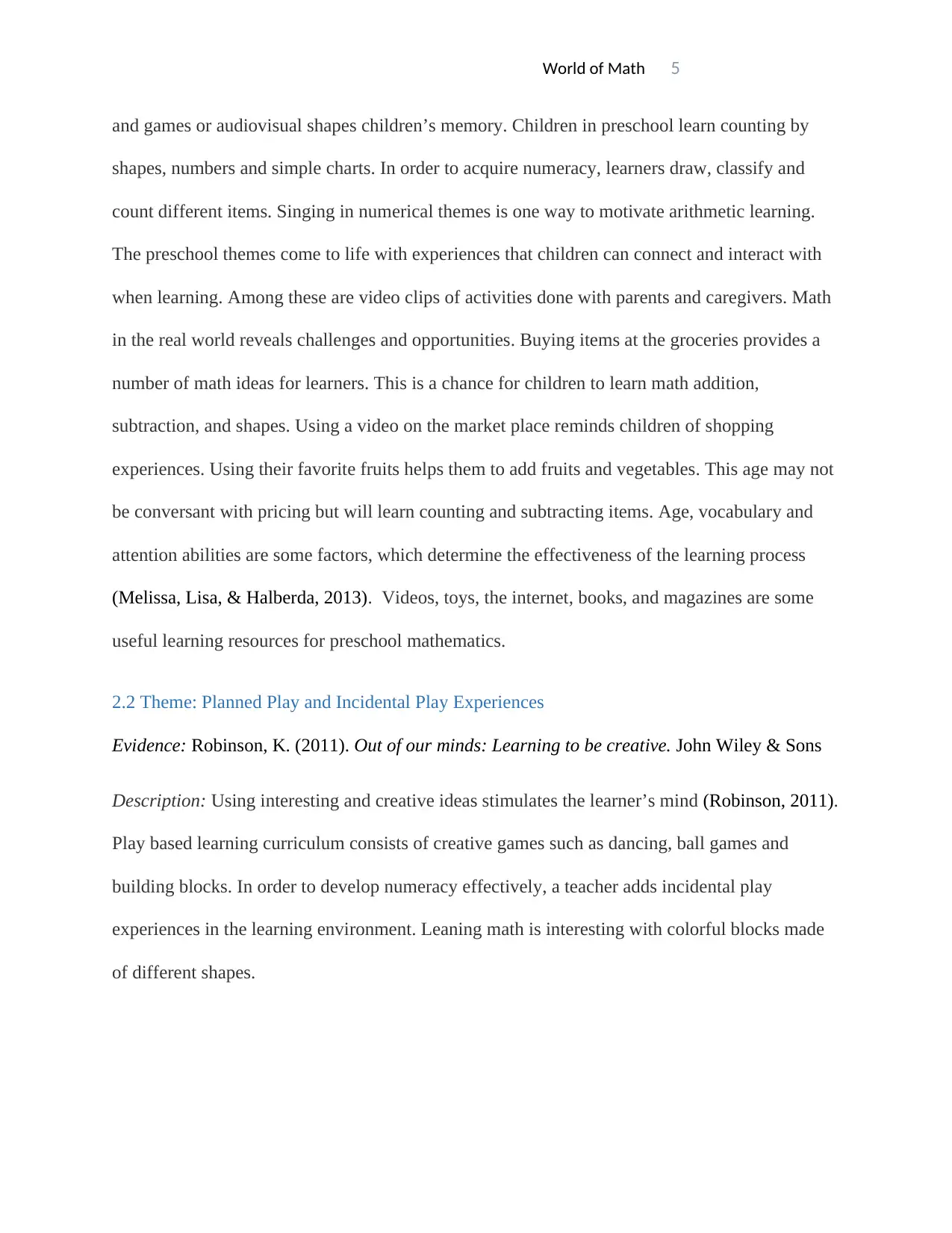
World of Math 5
and games or audiovisual shapes children’s memory. Children in preschool learn counting by
shapes, numbers and simple charts. In order to acquire numeracy, learners draw, classify and
count different items. Singing in numerical themes is one way to motivate arithmetic learning.
The preschool themes come to life with experiences that children can connect and interact with
when learning. Among these are video clips of activities done with parents and caregivers. Math
in the real world reveals challenges and opportunities. Buying items at the groceries provides a
number of math ideas for learners. This is a chance for children to learn math addition,
subtraction, and shapes. Using a video on the market place reminds children of shopping
experiences. Using their favorite fruits helps them to add fruits and vegetables. This age may not
be conversant with pricing but will learn counting and subtracting items. Age, vocabulary and
attention abilities are some factors, which determine the effectiveness of the learning process
(Melissa, Lisa, & Halberda, 2013). Videos, toys, the internet, books, and magazines are some
useful learning resources for preschool mathematics.
2.2 Theme: Planned Play and Incidental Play Experiences
Evidence: Robinson, K. (2011). Out of our minds: Learning to be creative. John Wiley & Sons
Description: Using interesting and creative ideas stimulates the learner’s mind (Robinson, 2011).
Play based learning curriculum consists of creative games such as dancing, ball games and
building blocks. In order to develop numeracy effectively, a teacher adds incidental play
experiences in the learning environment. Leaning math is interesting with colorful blocks made
of different shapes.
and games or audiovisual shapes children’s memory. Children in preschool learn counting by
shapes, numbers and simple charts. In order to acquire numeracy, learners draw, classify and
count different items. Singing in numerical themes is one way to motivate arithmetic learning.
The preschool themes come to life with experiences that children can connect and interact with
when learning. Among these are video clips of activities done with parents and caregivers. Math
in the real world reveals challenges and opportunities. Buying items at the groceries provides a
number of math ideas for learners. This is a chance for children to learn math addition,
subtraction, and shapes. Using a video on the market place reminds children of shopping
experiences. Using their favorite fruits helps them to add fruits and vegetables. This age may not
be conversant with pricing but will learn counting and subtracting items. Age, vocabulary and
attention abilities are some factors, which determine the effectiveness of the learning process
(Melissa, Lisa, & Halberda, 2013). Videos, toys, the internet, books, and magazines are some
useful learning resources for preschool mathematics.
2.2 Theme: Planned Play and Incidental Play Experiences
Evidence: Robinson, K. (2011). Out of our minds: Learning to be creative. John Wiley & Sons
Description: Using interesting and creative ideas stimulates the learner’s mind (Robinson, 2011).
Play based learning curriculum consists of creative games such as dancing, ball games and
building blocks. In order to develop numeracy effectively, a teacher adds incidental play
experiences in the learning environment. Leaning math is interesting with colorful blocks made
of different shapes.
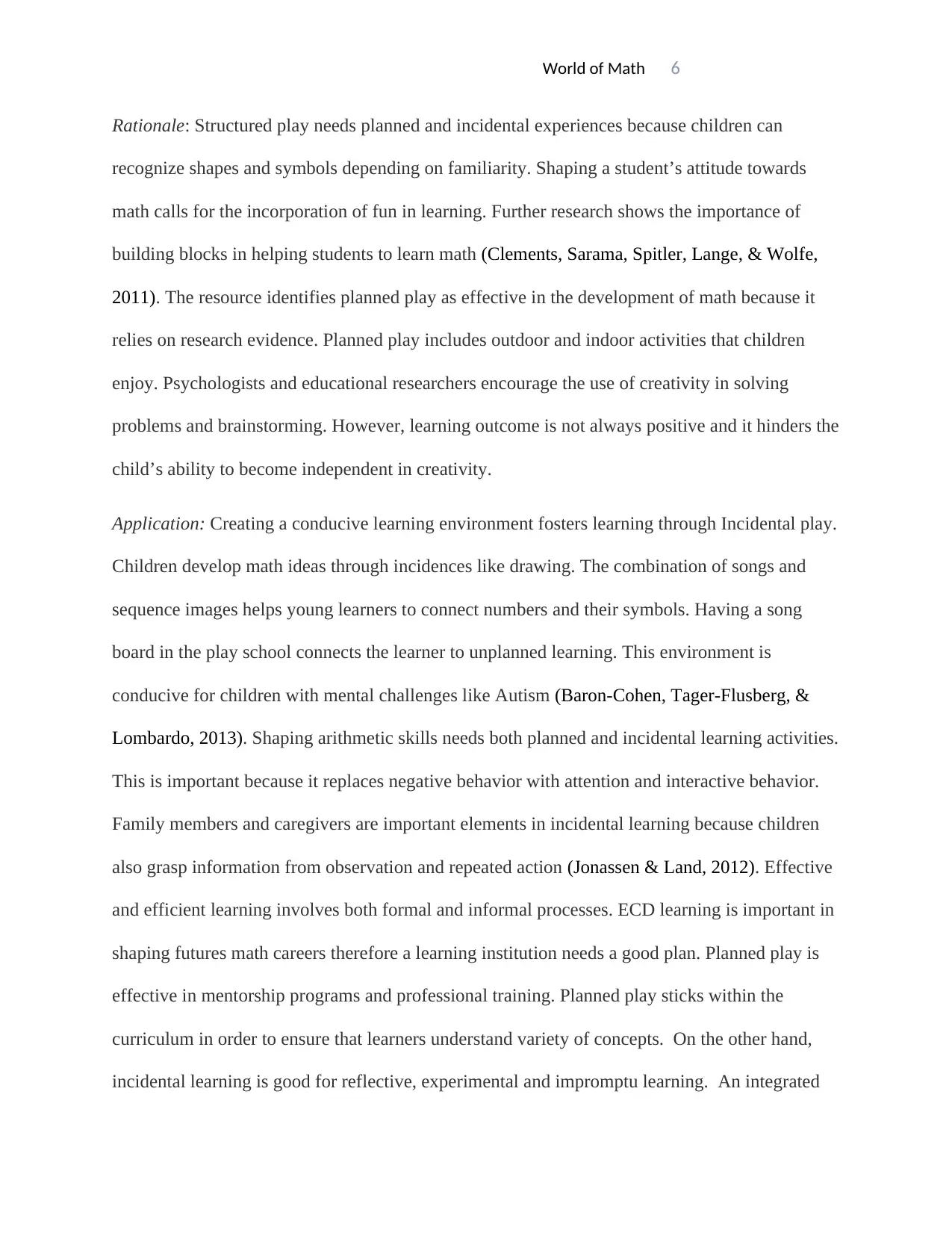
World of Math 6
Rationale: Structured play needs planned and incidental experiences because children can
recognize shapes and symbols depending on familiarity. Shaping a student’s attitude towards
math calls for the incorporation of fun in learning. Further research shows the importance of
building blocks in helping students to learn math (Clements, Sarama, Spitler, Lange, & Wolfe,
2011). The resource identifies planned play as effective in the development of math because it
relies on research evidence. Planned play includes outdoor and indoor activities that children
enjoy. Psychologists and educational researchers encourage the use of creativity in solving
problems and brainstorming. However, learning outcome is not always positive and it hinders the
child’s ability to become independent in creativity.
Application: Creating a conducive learning environment fosters learning through Incidental play.
Children develop math ideas through incidences like drawing. The combination of songs and
sequence images helps young learners to connect numbers and their symbols. Having a song
board in the play school connects the learner to unplanned learning. This environment is
conducive for children with mental challenges like Autism (Baron-Cohen, Tager-Flusberg, &
Lombardo, 2013). Shaping arithmetic skills needs both planned and incidental learning activities.
This is important because it replaces negative behavior with attention and interactive behavior.
Family members and caregivers are important elements in incidental learning because children
also grasp information from observation and repeated action (Jonassen & Land, 2012). Effective
and efficient learning involves both formal and informal processes. ECD learning is important in
shaping futures math careers therefore a learning institution needs a good plan. Planned play is
effective in mentorship programs and professional training. Planned play sticks within the
curriculum in order to ensure that learners understand variety of concepts. On the other hand,
incidental learning is good for reflective, experimental and impromptu learning. An integrated
Rationale: Structured play needs planned and incidental experiences because children can
recognize shapes and symbols depending on familiarity. Shaping a student’s attitude towards
math calls for the incorporation of fun in learning. Further research shows the importance of
building blocks in helping students to learn math (Clements, Sarama, Spitler, Lange, & Wolfe,
2011). The resource identifies planned play as effective in the development of math because it
relies on research evidence. Planned play includes outdoor and indoor activities that children
enjoy. Psychologists and educational researchers encourage the use of creativity in solving
problems and brainstorming. However, learning outcome is not always positive and it hinders the
child’s ability to become independent in creativity.
Application: Creating a conducive learning environment fosters learning through Incidental play.
Children develop math ideas through incidences like drawing. The combination of songs and
sequence images helps young learners to connect numbers and their symbols. Having a song
board in the play school connects the learner to unplanned learning. This environment is
conducive for children with mental challenges like Autism (Baron-Cohen, Tager-Flusberg, &
Lombardo, 2013). Shaping arithmetic skills needs both planned and incidental learning activities.
This is important because it replaces negative behavior with attention and interactive behavior.
Family members and caregivers are important elements in incidental learning because children
also grasp information from observation and repeated action (Jonassen & Land, 2012). Effective
and efficient learning involves both formal and informal processes. ECD learning is important in
shaping futures math careers therefore a learning institution needs a good plan. Planned play is
effective in mentorship programs and professional training. Planned play sticks within the
curriculum in order to ensure that learners understand variety of concepts. On the other hand,
incidental learning is good for reflective, experimental and impromptu learning. An integrated
⊘ This is a preview!⊘
Do you want full access?
Subscribe today to unlock all pages.

Trusted by 1+ million students worldwide
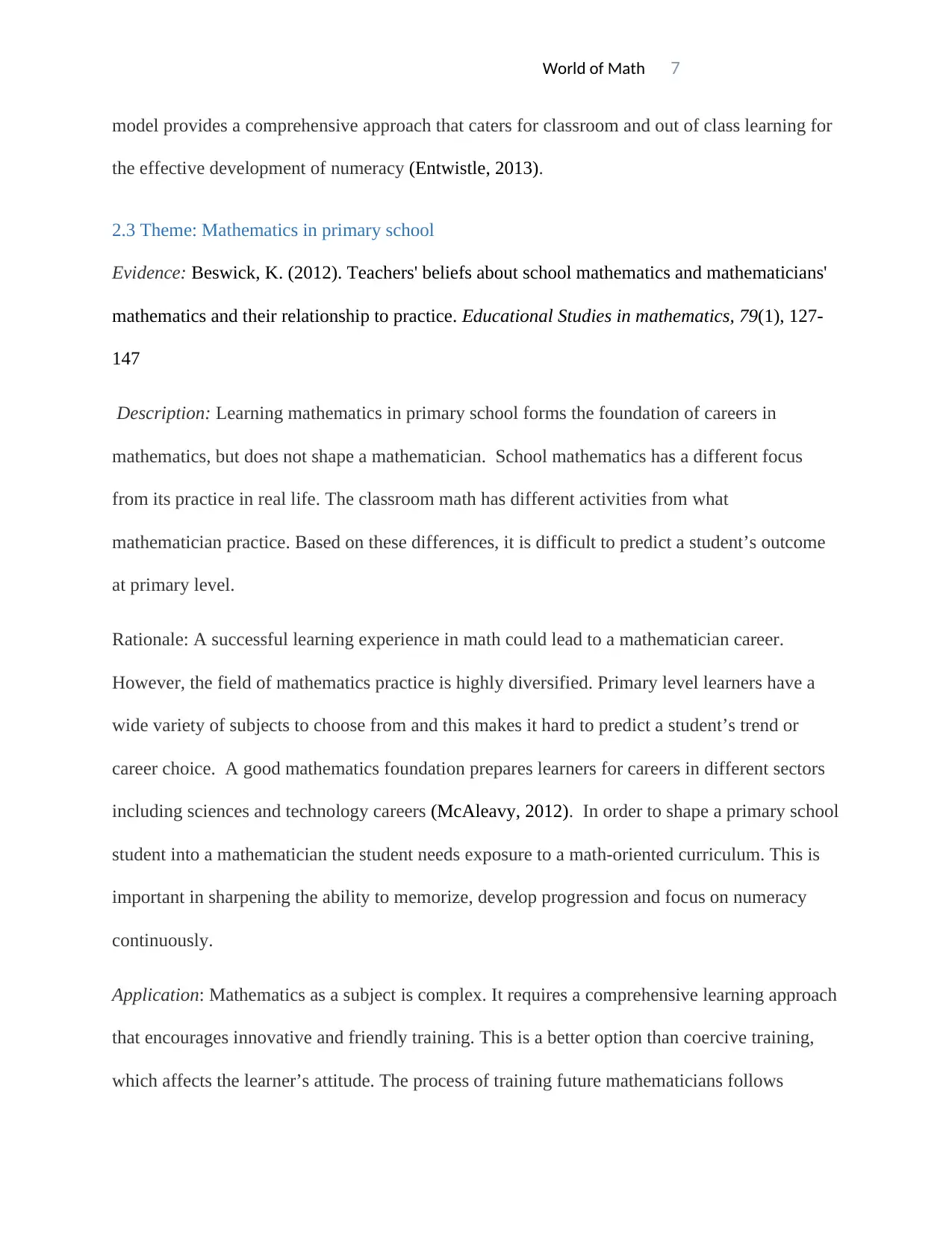
World of Math 7
model provides a comprehensive approach that caters for classroom and out of class learning for
the effective development of numeracy (Entwistle, 2013).
2.3 Theme: Mathematics in primary school
Evidence: Beswick, K. (2012). Teachers' beliefs about school mathematics and mathematicians'
mathematics and their relationship to practice. Educational Studies in mathematics, 79(1), 127-
147
Description: Learning mathematics in primary school forms the foundation of careers in
mathematics, but does not shape a mathematician. School mathematics has a different focus
from its practice in real life. The classroom math has different activities from what
mathematician practice. Based on these differences, it is difficult to predict a student’s outcome
at primary level.
Rationale: A successful learning experience in math could lead to a mathematician career.
However, the field of mathematics practice is highly diversified. Primary level learners have a
wide variety of subjects to choose from and this makes it hard to predict a student’s trend or
career choice. A good mathematics foundation prepares learners for careers in different sectors
including sciences and technology careers (McAleavy, 2012). In order to shape a primary school
student into a mathematician the student needs exposure to a math-oriented curriculum. This is
important in sharpening the ability to memorize, develop progression and focus on numeracy
continuously.
Application: Mathematics as a subject is complex. It requires a comprehensive learning approach
that encourages innovative and friendly training. This is a better option than coercive training,
which affects the learner’s attitude. The process of training future mathematicians follows
model provides a comprehensive approach that caters for classroom and out of class learning for
the effective development of numeracy (Entwistle, 2013).
2.3 Theme: Mathematics in primary school
Evidence: Beswick, K. (2012). Teachers' beliefs about school mathematics and mathematicians'
mathematics and their relationship to practice. Educational Studies in mathematics, 79(1), 127-
147
Description: Learning mathematics in primary school forms the foundation of careers in
mathematics, but does not shape a mathematician. School mathematics has a different focus
from its practice in real life. The classroom math has different activities from what
mathematician practice. Based on these differences, it is difficult to predict a student’s outcome
at primary level.
Rationale: A successful learning experience in math could lead to a mathematician career.
However, the field of mathematics practice is highly diversified. Primary level learners have a
wide variety of subjects to choose from and this makes it hard to predict a student’s trend or
career choice. A good mathematics foundation prepares learners for careers in different sectors
including sciences and technology careers (McAleavy, 2012). In order to shape a primary school
student into a mathematician the student needs exposure to a math-oriented curriculum. This is
important in sharpening the ability to memorize, develop progression and focus on numeracy
continuously.
Application: Mathematics as a subject is complex. It requires a comprehensive learning approach
that encourages innovative and friendly training. This is a better option than coercive training,
which affects the learner’s attitude. The process of training future mathematicians follows
Paraphrase This Document
Need a fresh take? Get an instant paraphrase of this document with our AI Paraphraser
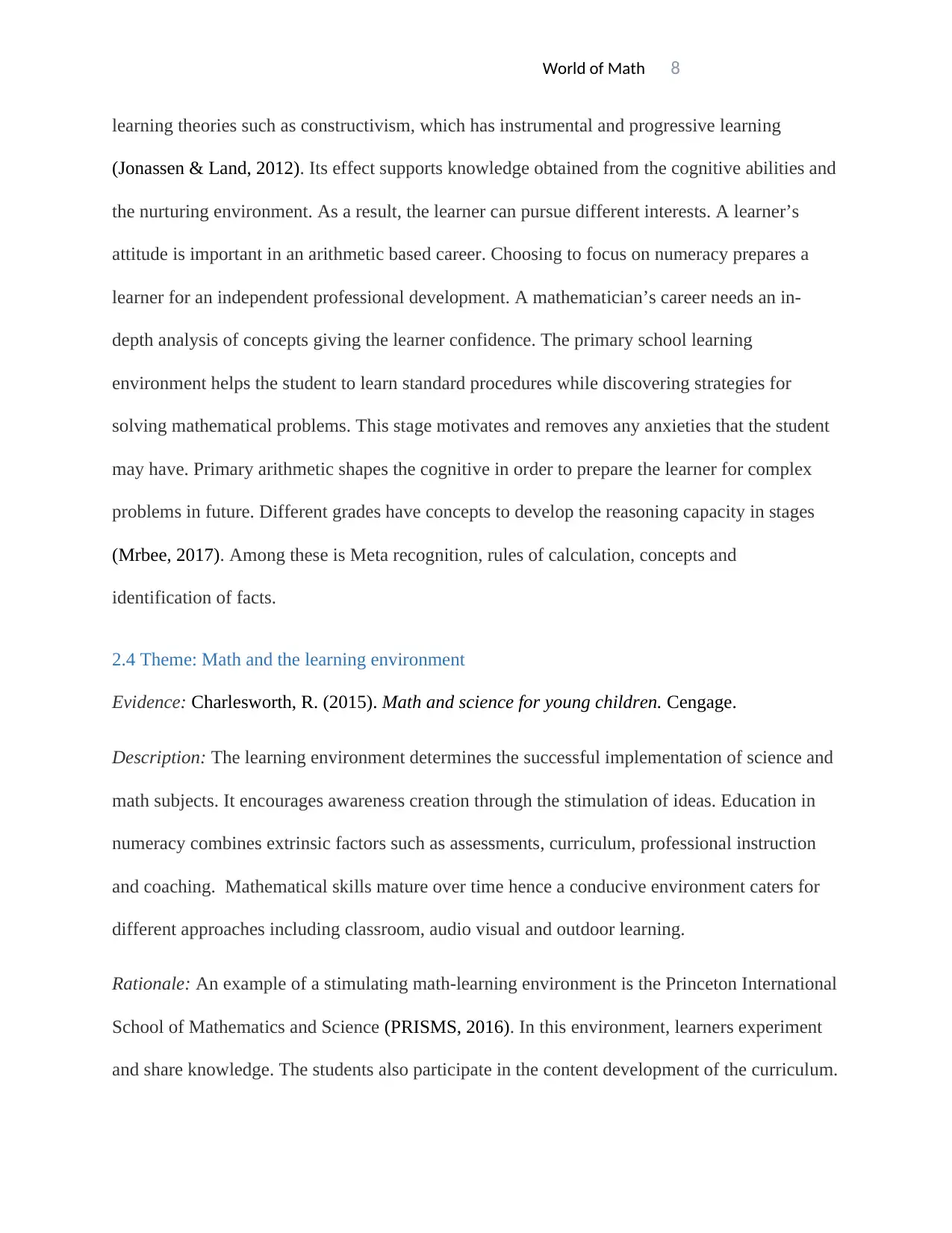
World of Math 8
learning theories such as constructivism, which has instrumental and progressive learning
(Jonassen & Land, 2012). Its effect supports knowledge obtained from the cognitive abilities and
the nurturing environment. As a result, the learner can pursue different interests. A learner’s
attitude is important in an arithmetic based career. Choosing to focus on numeracy prepares a
learner for an independent professional development. A mathematician’s career needs an in-
depth analysis of concepts giving the learner confidence. The primary school learning
environment helps the student to learn standard procedures while discovering strategies for
solving mathematical problems. This stage motivates and removes any anxieties that the student
may have. Primary arithmetic shapes the cognitive in order to prepare the learner for complex
problems in future. Different grades have concepts to develop the reasoning capacity in stages
(Mrbee, 2017). Among these is Meta recognition, rules of calculation, concepts and
identification of facts.
2.4 Theme: Math and the learning environment
Evidence: Charlesworth, R. (2015). Math and science for young children. Cengage.
Description: The learning environment determines the successful implementation of science and
math subjects. It encourages awareness creation through the stimulation of ideas. Education in
numeracy combines extrinsic factors such as assessments, curriculum, professional instruction
and coaching. Mathematical skills mature over time hence a conducive environment caters for
different approaches including classroom, audio visual and outdoor learning.
Rationale: An example of a stimulating math-learning environment is the Princeton International
School of Mathematics and Science (PRISMS, 2016). In this environment, learners experiment
and share knowledge. The students also participate in the content development of the curriculum.
learning theories such as constructivism, which has instrumental and progressive learning
(Jonassen & Land, 2012). Its effect supports knowledge obtained from the cognitive abilities and
the nurturing environment. As a result, the learner can pursue different interests. A learner’s
attitude is important in an arithmetic based career. Choosing to focus on numeracy prepares a
learner for an independent professional development. A mathematician’s career needs an in-
depth analysis of concepts giving the learner confidence. The primary school learning
environment helps the student to learn standard procedures while discovering strategies for
solving mathematical problems. This stage motivates and removes any anxieties that the student
may have. Primary arithmetic shapes the cognitive in order to prepare the learner for complex
problems in future. Different grades have concepts to develop the reasoning capacity in stages
(Mrbee, 2017). Among these is Meta recognition, rules of calculation, concepts and
identification of facts.
2.4 Theme: Math and the learning environment
Evidence: Charlesworth, R. (2015). Math and science for young children. Cengage.
Description: The learning environment determines the successful implementation of science and
math subjects. It encourages awareness creation through the stimulation of ideas. Education in
numeracy combines extrinsic factors such as assessments, curriculum, professional instruction
and coaching. Mathematical skills mature over time hence a conducive environment caters for
different approaches including classroom, audio visual and outdoor learning.
Rationale: An example of a stimulating math-learning environment is the Princeton International
School of Mathematics and Science (PRISMS, 2016). In this environment, learners experiment
and share knowledge. The students also participate in the content development of the curriculum.
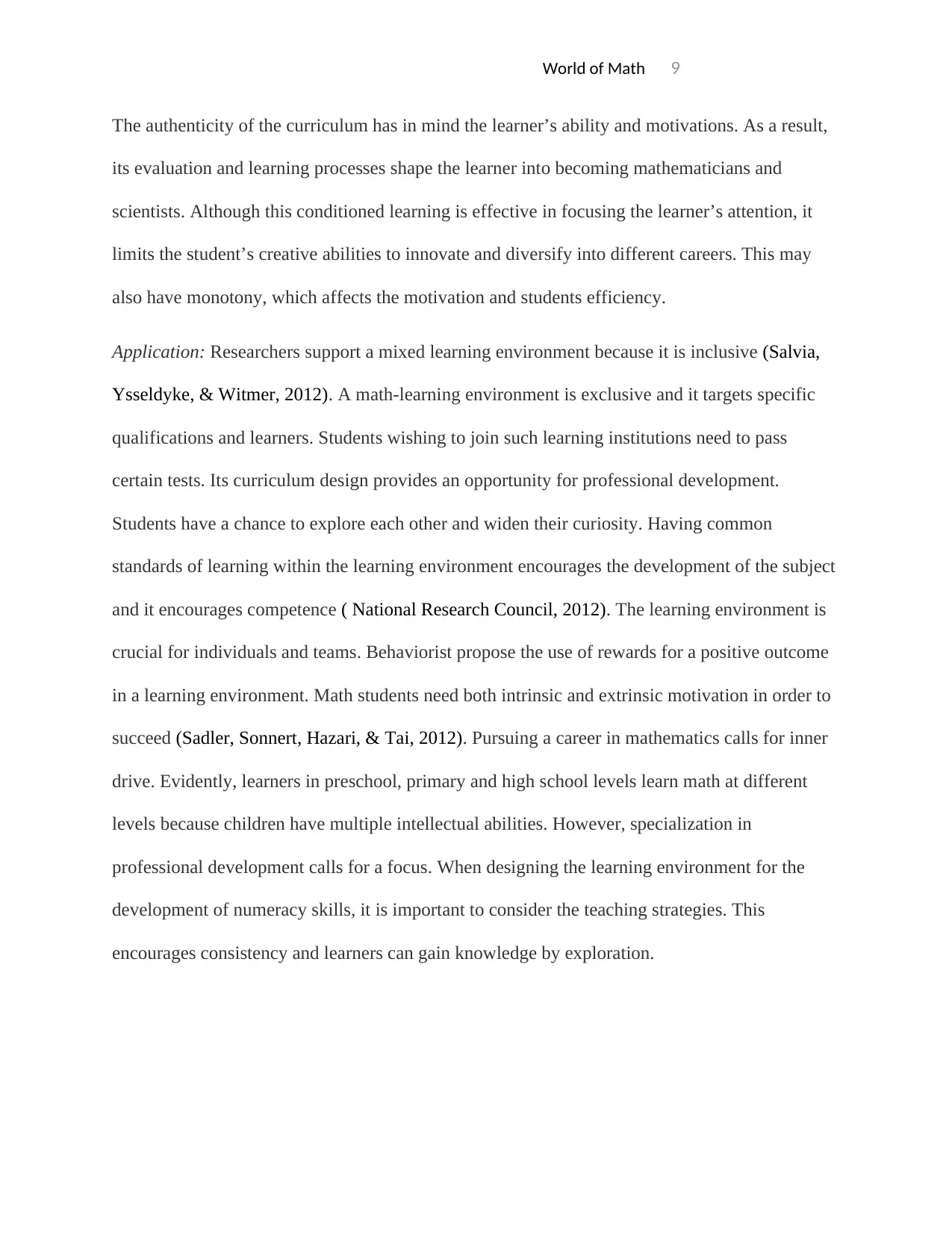
World of Math 9
The authenticity of the curriculum has in mind the learner’s ability and motivations. As a result,
its evaluation and learning processes shape the learner into becoming mathematicians and
scientists. Although this conditioned learning is effective in focusing the learner’s attention, it
limits the student’s creative abilities to innovate and diversify into different careers. This may
also have monotony, which affects the motivation and students efficiency.
Application: Researchers support a mixed learning environment because it is inclusive (Salvia,
Ysseldyke, & Witmer, 2012). A math-learning environment is exclusive and it targets specific
qualifications and learners. Students wishing to join such learning institutions need to pass
certain tests. Its curriculum design provides an opportunity for professional development.
Students have a chance to explore each other and widen their curiosity. Having common
standards of learning within the learning environment encourages the development of the subject
and it encourages competence ( National Research Council, 2012). The learning environment is
crucial for individuals and teams. Behaviorist propose the use of rewards for a positive outcome
in a learning environment. Math students need both intrinsic and extrinsic motivation in order to
succeed (Sadler, Sonnert, Hazari, & Tai, 2012). Pursuing a career in mathematics calls for inner
drive. Evidently, learners in preschool, primary and high school levels learn math at different
levels because children have multiple intellectual abilities. However, specialization in
professional development calls for a focus. When designing the learning environment for the
development of numeracy skills, it is important to consider the teaching strategies. This
encourages consistency and learners can gain knowledge by exploration.
The authenticity of the curriculum has in mind the learner’s ability and motivations. As a result,
its evaluation and learning processes shape the learner into becoming mathematicians and
scientists. Although this conditioned learning is effective in focusing the learner’s attention, it
limits the student’s creative abilities to innovate and diversify into different careers. This may
also have monotony, which affects the motivation and students efficiency.
Application: Researchers support a mixed learning environment because it is inclusive (Salvia,
Ysseldyke, & Witmer, 2012). A math-learning environment is exclusive and it targets specific
qualifications and learners. Students wishing to join such learning institutions need to pass
certain tests. Its curriculum design provides an opportunity for professional development.
Students have a chance to explore each other and widen their curiosity. Having common
standards of learning within the learning environment encourages the development of the subject
and it encourages competence ( National Research Council, 2012). The learning environment is
crucial for individuals and teams. Behaviorist propose the use of rewards for a positive outcome
in a learning environment. Math students need both intrinsic and extrinsic motivation in order to
succeed (Sadler, Sonnert, Hazari, & Tai, 2012). Pursuing a career in mathematics calls for inner
drive. Evidently, learners in preschool, primary and high school levels learn math at different
levels because children have multiple intellectual abilities. However, specialization in
professional development calls for a focus. When designing the learning environment for the
development of numeracy skills, it is important to consider the teaching strategies. This
encourages consistency and learners can gain knowledge by exploration.
⊘ This is a preview!⊘
Do you want full access?
Subscribe today to unlock all pages.

Trusted by 1+ million students worldwide
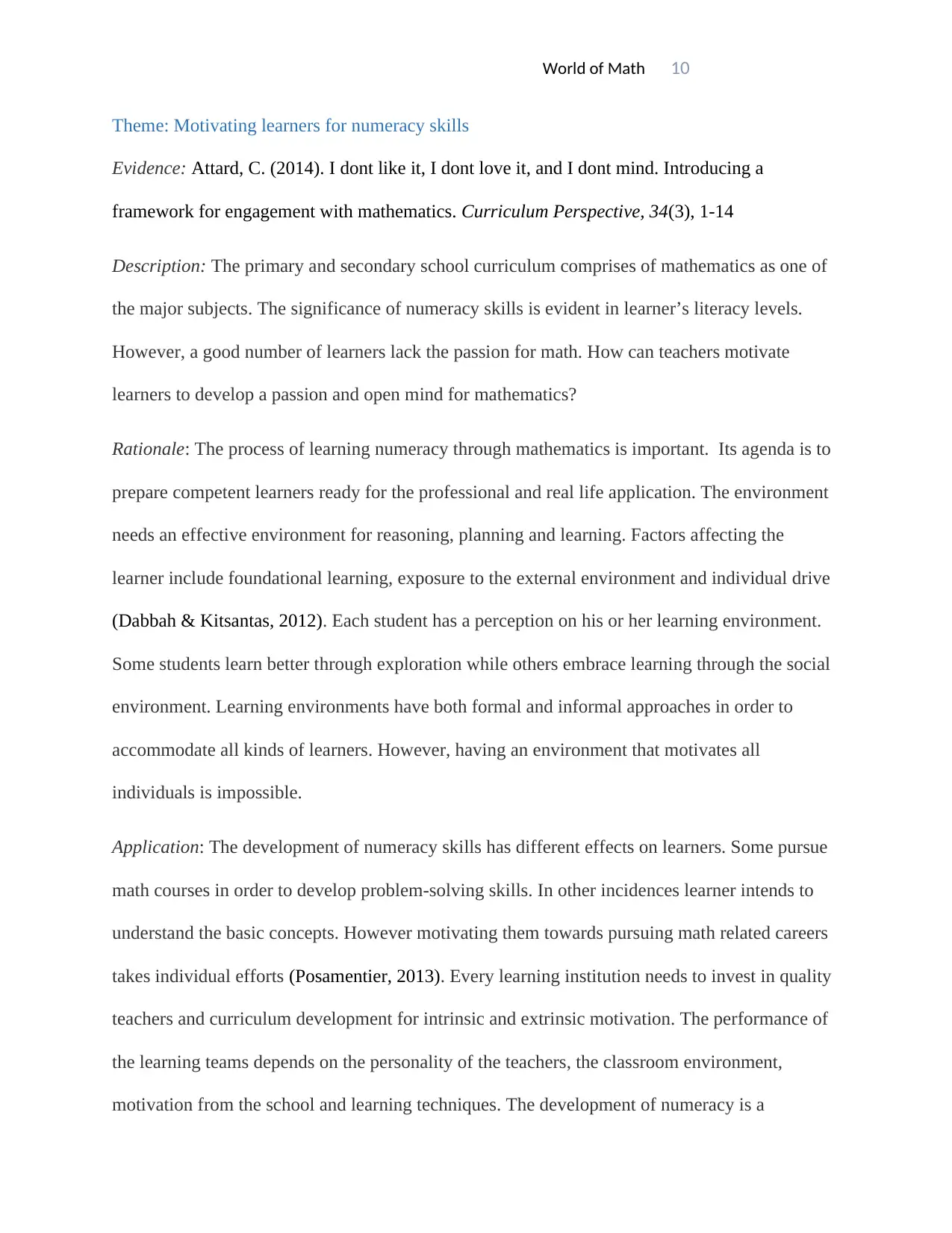
World of Math 10
Theme: Motivating learners for numeracy skills
Evidence: Attard, C. (2014). I dont like it, I dont love it, and I dont mind. Introducing a
framework for engagement with mathematics. Curriculum Perspective, 34(3), 1-14
Description: The primary and secondary school curriculum comprises of mathematics as one of
the major subjects. The significance of numeracy skills is evident in learner’s literacy levels.
However, a good number of learners lack the passion for math. How can teachers motivate
learners to develop a passion and open mind for mathematics?
Rationale: The process of learning numeracy through mathematics is important. Its agenda is to
prepare competent learners ready for the professional and real life application. The environment
needs an effective environment for reasoning, planning and learning. Factors affecting the
learner include foundational learning, exposure to the external environment and individual drive
(Dabbah & Kitsantas, 2012). Each student has a perception on his or her learning environment.
Some students learn better through exploration while others embrace learning through the social
environment. Learning environments have both formal and informal approaches in order to
accommodate all kinds of learners. However, having an environment that motivates all
individuals is impossible.
Application: The development of numeracy skills has different effects on learners. Some pursue
math courses in order to develop problem-solving skills. In other incidences learner intends to
understand the basic concepts. However motivating them towards pursuing math related careers
takes individual efforts (Posamentier, 2013). Every learning institution needs to invest in quality
teachers and curriculum development for intrinsic and extrinsic motivation. The performance of
the learning teams depends on the personality of the teachers, the classroom environment,
motivation from the school and learning techniques. The development of numeracy is a
Theme: Motivating learners for numeracy skills
Evidence: Attard, C. (2014). I dont like it, I dont love it, and I dont mind. Introducing a
framework for engagement with mathematics. Curriculum Perspective, 34(3), 1-14
Description: The primary and secondary school curriculum comprises of mathematics as one of
the major subjects. The significance of numeracy skills is evident in learner’s literacy levels.
However, a good number of learners lack the passion for math. How can teachers motivate
learners to develop a passion and open mind for mathematics?
Rationale: The process of learning numeracy through mathematics is important. Its agenda is to
prepare competent learners ready for the professional and real life application. The environment
needs an effective environment for reasoning, planning and learning. Factors affecting the
learner include foundational learning, exposure to the external environment and individual drive
(Dabbah & Kitsantas, 2012). Each student has a perception on his or her learning environment.
Some students learn better through exploration while others embrace learning through the social
environment. Learning environments have both formal and informal approaches in order to
accommodate all kinds of learners. However, having an environment that motivates all
individuals is impossible.
Application: The development of numeracy skills has different effects on learners. Some pursue
math courses in order to develop problem-solving skills. In other incidences learner intends to
understand the basic concepts. However motivating them towards pursuing math related careers
takes individual efforts (Posamentier, 2013). Every learning institution needs to invest in quality
teachers and curriculum development for intrinsic and extrinsic motivation. The performance of
the learning teams depends on the personality of the teachers, the classroom environment,
motivation from the school and learning techniques. The development of numeracy is a
Paraphrase This Document
Need a fresh take? Get an instant paraphrase of this document with our AI Paraphraser
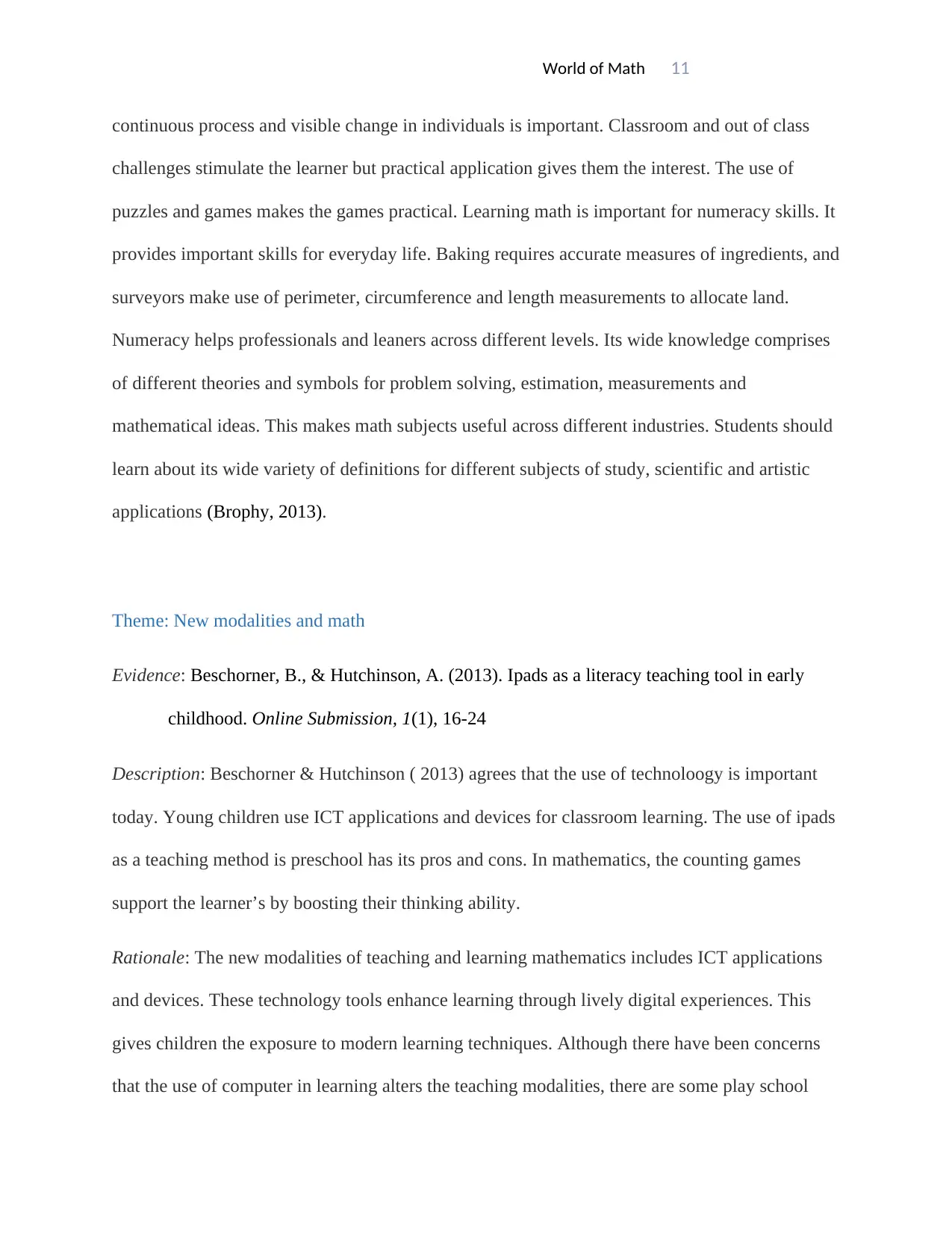
World of Math 11
continuous process and visible change in individuals is important. Classroom and out of class
challenges stimulate the learner but practical application gives them the interest. The use of
puzzles and games makes the games practical. Learning math is important for numeracy skills. It
provides important skills for everyday life. Baking requires accurate measures of ingredients, and
surveyors make use of perimeter, circumference and length measurements to allocate land.
Numeracy helps professionals and leaners across different levels. Its wide knowledge comprises
of different theories and symbols for problem solving, estimation, measurements and
mathematical ideas. This makes math subjects useful across different industries. Students should
learn about its wide variety of definitions for different subjects of study, scientific and artistic
applications (Brophy, 2013).
Theme: New modalities and math
Evidence: Beschorner, B., & Hutchinson, A. (2013). Ipads as a literacy teaching tool in early
childhood. Online Submission, 1(1), 16-24
Description: Beschorner & Hutchinson ( 2013) agrees that the use of technoloogy is important
today. Young children use ICT applications and devices for classroom learning. The use of ipads
as a teaching method is preschool has its pros and cons. In mathematics, the counting games
support the learner’s by boosting their thinking ability.
Rationale: The new modalities of teaching and learning mathematics includes ICT applications
and devices. These technology tools enhance learning through lively digital experiences. This
gives children the exposure to modern learning techniques. Although there have been concerns
that the use of computer in learning alters the teaching modalities, there are some play school
continuous process and visible change in individuals is important. Classroom and out of class
challenges stimulate the learner but practical application gives them the interest. The use of
puzzles and games makes the games practical. Learning math is important for numeracy skills. It
provides important skills for everyday life. Baking requires accurate measures of ingredients, and
surveyors make use of perimeter, circumference and length measurements to allocate land.
Numeracy helps professionals and leaners across different levels. Its wide knowledge comprises
of different theories and symbols for problem solving, estimation, measurements and
mathematical ideas. This makes math subjects useful across different industries. Students should
learn about its wide variety of definitions for different subjects of study, scientific and artistic
applications (Brophy, 2013).
Theme: New modalities and math
Evidence: Beschorner, B., & Hutchinson, A. (2013). Ipads as a literacy teaching tool in early
childhood. Online Submission, 1(1), 16-24
Description: Beschorner & Hutchinson ( 2013) agrees that the use of technoloogy is important
today. Young children use ICT applications and devices for classroom learning. The use of ipads
as a teaching method is preschool has its pros and cons. In mathematics, the counting games
support the learner’s by boosting their thinking ability.
Rationale: The new modalities of teaching and learning mathematics includes ICT applications
and devices. These technology tools enhance learning through lively digital experiences. This
gives children the exposure to modern learning techniques. Although there have been concerns
that the use of computer in learning alters the teaching modalities, there are some play school
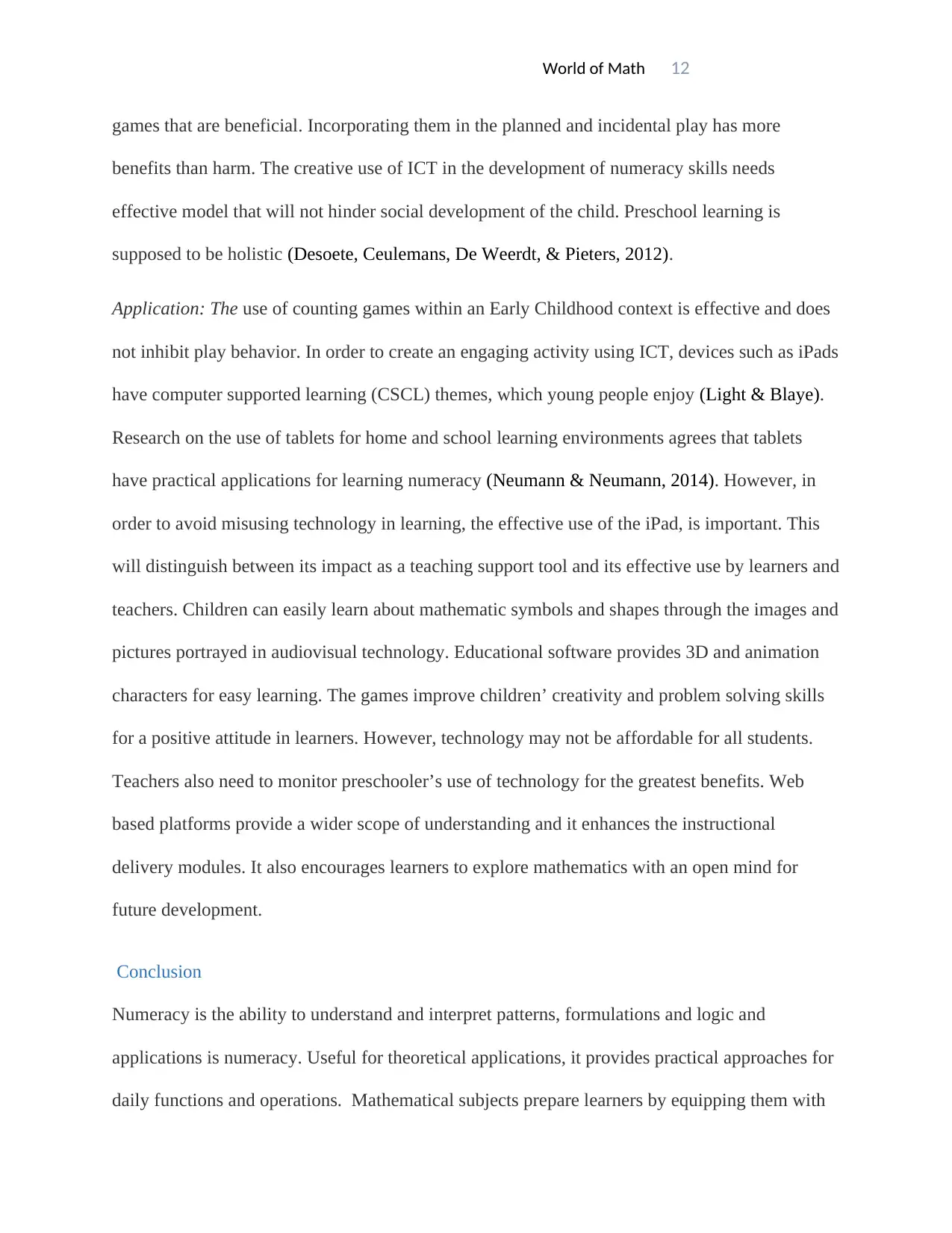
World of Math 12
games that are beneficial. Incorporating them in the planned and incidental play has more
benefits than harm. The creative use of ICT in the development of numeracy skills needs
effective model that will not hinder social development of the child. Preschool learning is
supposed to be holistic (Desoete, Ceulemans, De Weerdt, & Pieters, 2012).
Application: The use of counting games within an Early Childhood context is effective and does
not inhibit play behavior. In order to create an engaging activity using ICT, devices such as iPads
have computer supported learning (CSCL) themes, which young people enjoy (Light & Blaye).
Research on the use of tablets for home and school learning environments agrees that tablets
have practical applications for learning numeracy (Neumann & Neumann, 2014). However, in
order to avoid misusing technology in learning, the effective use of the iPad, is important. This
will distinguish between its impact as a teaching support tool and its effective use by learners and
teachers. Children can easily learn about mathematic symbols and shapes through the images and
pictures portrayed in audiovisual technology. Educational software provides 3D and animation
characters for easy learning. The games improve children’ creativity and problem solving skills
for a positive attitude in learners. However, technology may not be affordable for all students.
Teachers also need to monitor preschooler’s use of technology for the greatest benefits. Web
based platforms provide a wider scope of understanding and it enhances the instructional
delivery modules. It also encourages learners to explore mathematics with an open mind for
future development.
Conclusion
Numeracy is the ability to understand and interpret patterns, formulations and logic and
applications is numeracy. Useful for theoretical applications, it provides practical approaches for
daily functions and operations. Mathematical subjects prepare learners by equipping them with
games that are beneficial. Incorporating them in the planned and incidental play has more
benefits than harm. The creative use of ICT in the development of numeracy skills needs
effective model that will not hinder social development of the child. Preschool learning is
supposed to be holistic (Desoete, Ceulemans, De Weerdt, & Pieters, 2012).
Application: The use of counting games within an Early Childhood context is effective and does
not inhibit play behavior. In order to create an engaging activity using ICT, devices such as iPads
have computer supported learning (CSCL) themes, which young people enjoy (Light & Blaye).
Research on the use of tablets for home and school learning environments agrees that tablets
have practical applications for learning numeracy (Neumann & Neumann, 2014). However, in
order to avoid misusing technology in learning, the effective use of the iPad, is important. This
will distinguish between its impact as a teaching support tool and its effective use by learners and
teachers. Children can easily learn about mathematic symbols and shapes through the images and
pictures portrayed in audiovisual technology. Educational software provides 3D and animation
characters for easy learning. The games improve children’ creativity and problem solving skills
for a positive attitude in learners. However, technology may not be affordable for all students.
Teachers also need to monitor preschooler’s use of technology for the greatest benefits. Web
based platforms provide a wider scope of understanding and it enhances the instructional
delivery modules. It also encourages learners to explore mathematics with an open mind for
future development.
Conclusion
Numeracy is the ability to understand and interpret patterns, formulations and logic and
applications is numeracy. Useful for theoretical applications, it provides practical approaches for
daily functions and operations. Mathematical subjects prepare learners by equipping them with
⊘ This is a preview!⊘
Do you want full access?
Subscribe today to unlock all pages.

Trusted by 1+ million students worldwide
1 out of 17
Related Documents
Your All-in-One AI-Powered Toolkit for Academic Success.
+13062052269
info@desklib.com
Available 24*7 on WhatsApp / Email
![[object Object]](/_next/static/media/star-bottom.7253800d.svg)
Unlock your academic potential
Copyright © 2020–2025 A2Z Services. All Rights Reserved. Developed and managed by ZUCOL.





